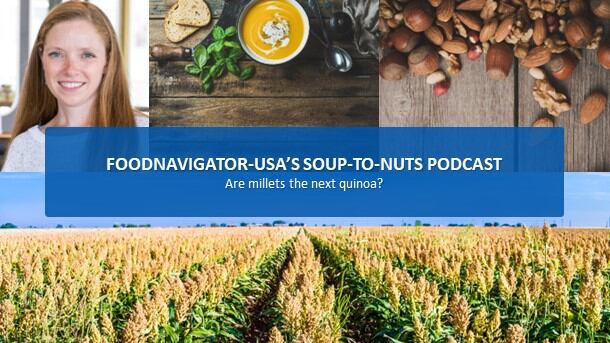When FAO and the UN declared 2013 the International Year of Quinoa, few Americans knew what the grain was or how to pronounce it, but now the grain is a staple in most US homes, a sought after ingredient in packaged foods and a common feature on restaurant menus. A similar trajectory of feverish R&D for CPGs featuring pulses also happened following 2016 when the UN declared that The International Year Of Pulses, such as lentils and beans.
While few suppliers and CPG in North America have embraced millets’ marketing potential so far, early adopters share in this episode of FoodNavigator-USA’s Soup-To-Nuts podcast their enthusiasm and strategy for simultaneously promoting and riding millets’ coattails to the top. Ingredient supplier Ardent Mills and food-tech startup Rainfed Foods also share challenges and strategies for developing reliable supply chains and innovating new products, as well as the environmental, nutritional and economic benefits of millets that make them worth fighting for.
[Editor’s note: Never miss an episode of FoodNavigator-USA’s Soup-To-Nuts podcast – subscribe today.]
What makes millets so special?
The UN’s decision to declare 2023 The International Year Of Millets may be surprising to the few Americans who know what millets are and most likely associate it with bird food, which is how it is predominantly used here.
But as Rainfed Foods Founder and CEO Sujala Balaji explains the family of cereal grains that make up millets actually has a long history as a staple in the human diet that was derailed, partly by the US government in the 1960s and ‘70s during the Green Revolution, when the intensification of crops like rice and wheat were promoted to boost access to calories. The unintended consequence was a loss of nutrition.
She adds the UN’s decision to put its marketing muscle behind millets in 2023 could undo some of the damage caused by that movement.
“Millets are actually great in micro- and macronutrients, they are a low glycemic crop [that are] clinically proven to reverse diabetes if consumed regularly,” and they are packed with fiber, which many Americans are low in, she explained.
UN’s decision to make 2023 The International Year of Millets is a “big deal” because it can have a powerful impact on consumer interest, product innovation, supply development and sales, she added.
Millets' drought-tolerance make them ideal for regenerative agriculture
The decision to highlight millets isn’t just good for human health, but also that of the planet, according to Balaji, who explained their status as drought resistant makes them an appealing alternative to grains that are suffering yield declines due to water shortages.
Millets also are a fast-growing so they are easy for farmers to rotate after more environmentally taxing but higher paying commodity crops.
This in turn gives farmers an additional source of income for times when their land might be fallow, she added.
Building supply and demand simultaneously
To fully seize the potential that millets offer, industry must simultaneously build consumer demand and a stable supply chain, neither of which is easy but which Rainfed and Ardent Mills are tackling head on.
Rainfed is focused on building demand by incorporating millets into products with which consumers are already familiar, such a plant-based milk, and by creating a portfolio of versatile millet-based ingredients that other CPG manufacturers can easily incorporate across a range of products.
“In North America, in the US and Canada, a lot of the millets that are grown are really going into applications like bird seed and animal feed and some gets exported for biofuel applications. And we just need to really explore the applications in food,” she said.
Rainfed is launching in Canada soon two plant-based milks that blend millets with peas to create a beverage that is nutritionally equivalent to dairy milk, and which is a familiar, accessible format for consumers – making it easier for them to try than a bag of dry grain that they might not know how to use.
On the ingredient side, Rainfed is creating a spray dried powder format that Balaji says is more versatile than flour, and will be ready to launch in the fall.
Millets are a cost-effective, gluten-free option for startups
Ardent Mills sees potential for millet as a gluten-free option that works well in blends, and as a less expensive option for smaller companies and startups, according to general manager Shrene White.
“This is one of the those grains where if you are a startup company and you’re looking for something that is maybe a little more economical than some of the other opportunities for grains out there that are gluten free, this is a really good entry point,” she said.
She also noted that millet can be puffed or made into grains, giving manufacturers options for different textures and uses.
Building a supply
As demand for millet inevitably increases, Rainfed and Ardent Mills are aggressively building up a reliable supply chain.
Balaji said she is concentrating on sourcing millet from India, because that is where she was born and believes it can have a significant social impact on farmers there.
Ardent Mills is helping to build out the supply chain for Millet in the US by concentrating on regions that struggle with droughts, according to White, who added the company also is promoting the grain as a tool for regenerative farming and low-cost rotational crop.
With so many factors in millets’ favor and the emerging support of industry as well as the UN, the coming year will be a telling one for the grains, which those who are interested can learn more about at https://www.fao.org/millets-2023/en.

